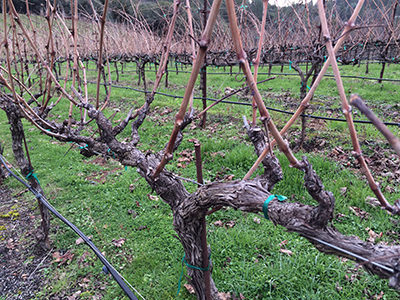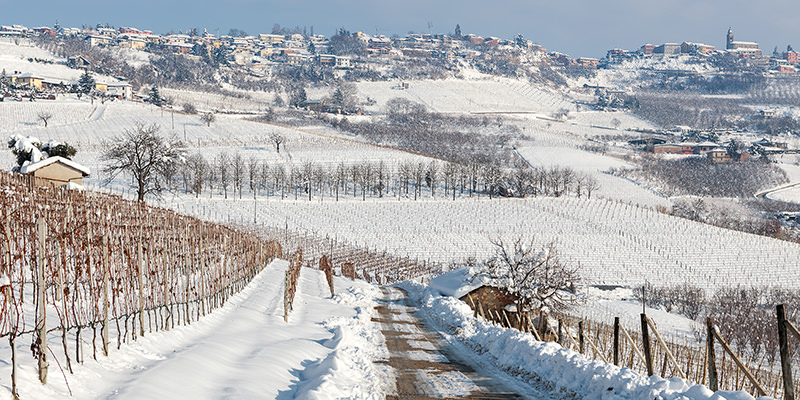Images of winter in the vineyard make the vines look sturdy, tranquil, and often quite dead. But beneath the picture-perfect dusting of snowflakes across Tuscany or clovers that blanket dormant Napa vineyards, there’s an incredible amount of microscopic activity happening the in the vineyard. Dormant vines are far from dead, and they’re not just asleep, either.
Contrary to what ordinary vineyard tours would have guests believe, grape vines don’t simply collapse into dormancy once harvest is over, as a mother might collapse into bed after twin toddlers are finally asleep. In fact, the time between harvest and fall’s first frost (when dormancy becomes visible) is one of the most active, important, and forgotten periods in a vineyard.
If you’ve never thought about this mysterious in-between time, you’re not alone. Luckily, viticulturalist Ann Kraemer has been tending vines for decades and easily turned science-speak into plain English on a recent adventure through her Amador County ranch in Northern California. From vineyards as large as Domaine Chandon’s 880-acre estate, and as outlandish as Swanson’s un-pruned Merlot vineyard, she’s been watching vines through winter since 1982, and is quick to mention that they remain active beneath their bark all year long.
The autumn grape harvest marks the beginning of a grapevine’s bedtime ritual, and like a young child’s, preparing grapevines for a sound winter’s rest is a long process. According to Kraemer, vines breathe a huge “sigh of relief” once their grapes have been picked.
“For months, ripening these grapes is all that the plant has been focused on, and once they’re harvested they finally have energy to move on to something else.”
First, the energetic vine sends out lots of new roots in what’s known as a root flush. This root flush consists of tiny root hairs — like the miniscule strings on the ends of carrots or beets at a farmers’ market — to retrieve nutrients from the soil, while the plant’s leaves continue photosynthesis. Like a bedtime snack, this root flush fills the vine up for its winter slumber. Beyond preventing vinous stomach rumbling, the results of the root flush are what allow vines to survive sub-freezing temperatures from November to March.
The secret to their success is the vine’s ability to resist freezing. When temperatures drop below 32 degrees, it’s not only water in lakes and puddles that freezes, but also water inside plants, grapevines and trees. Concentrating sugar and starch in water, which is the end result of the root flush combined with photosynthesis, reduces the vine’s internal freezing point down to as low as twelve degrees. This allows the vines to literally steel themselves from the inside out. According to Kraemer, vines ideally have four to six weeks between harvest and the first frost–which kills the leaves and halts photosynthesis–to store enough carbohydrates to withstand winter. Without this critical storage time, vine branches won’t have enough carbohydrates, will easily freeze and die.

Once the fruit is harvested, growers like Kraemer get their hands dirty one more time. Like baby monitors, growers keep a watchful eye on vines as weather changes, often bringing essential rain to arid regions. Practices vary across regions and vineyards, but most growers tuck in the vines by laying straw between the rows, planting their first cover crop, or spreading 282 tons of compost in Kraemer’s case. Rather than preventing cold, these tricks cut down soil erosion by preventing storms from pummeling raw soil and creating rivers of runoff, or in the case of compost, add vital soil nutrients. The tiny root systems of cover crops like clover and native grasses hold soils tightly together, while hay or straw break up and slow raindrops so the water can be slowly absorbed into the soil instead of flowing downhill and taking vital nutrients with it.
Especially in wet El Niño years, it’s critical that rainwater arrives steadily — instead of in a single monsoon — which stresses the vines in addition to ruining soil integrity. Vine roots sense changes in soil moisture content throughout the winter, and too much, or too little in the case of California’s historic drought, causes undue stress on the vine, like sleeping fitfully in a room that’s too hot or too cold.
“If I didn’t also sell wine, I’d definitely be on vacation,” says Kraemer of the slow winter season in the vineyard. Through most of it, her staff is half of its summertime size because, despite activity inside the vines, there isn’t much physical work to do.
“This is the planning, budgeting, tax-paying season, until February when we start checking in on things and pruning.”
Pruning not only keeps vineyards looking charming to the untrained eye, but sets the stage for the entire growing season. At Kraemer’s high elevation ranch, she and the team begin the process in February or March by walking through the vineyard and examining each vine, looking for evidence of a strong previous year or threats like the wood fungus eutypa, which can be spread by rain to fresh pruning cuts. Depending on the grape variety and pruning style of each vine, Kraemer and her team select one or three buds to keep for the coming year and trim off the rest, determining potential crop loads for the season before the vine has even begun to wake up.
With a team of four, and a 46-acre vineyard, the operation takes about eight weeks from start to finish. Some vineyards prune mechanically, and more quickly but for Kraemer, a small, well-trained team is worth the extra time.
Pruning stimulates the vines like a gentle back rub, and the first mention of spring sunshine. If all goes well, Mother Nature brings steadily rising temperatures, and these new buds burst open in March and April, as stored water and starch from fall’s root flush begin coursing through the vine branches and roots once again. Then it’s all hands on deck for another sunny season.

